Toasted Coconut Almond Butter
Making homemade Almond Coconut Butter has never been easier, and the creamy, dreamy payoff is SO worth it—just 5 ingredients and a food processor, and you’ll have a jar of creamy, nutty, toasty goodness ready to spread on anything and everything! Makes 18 ounces.
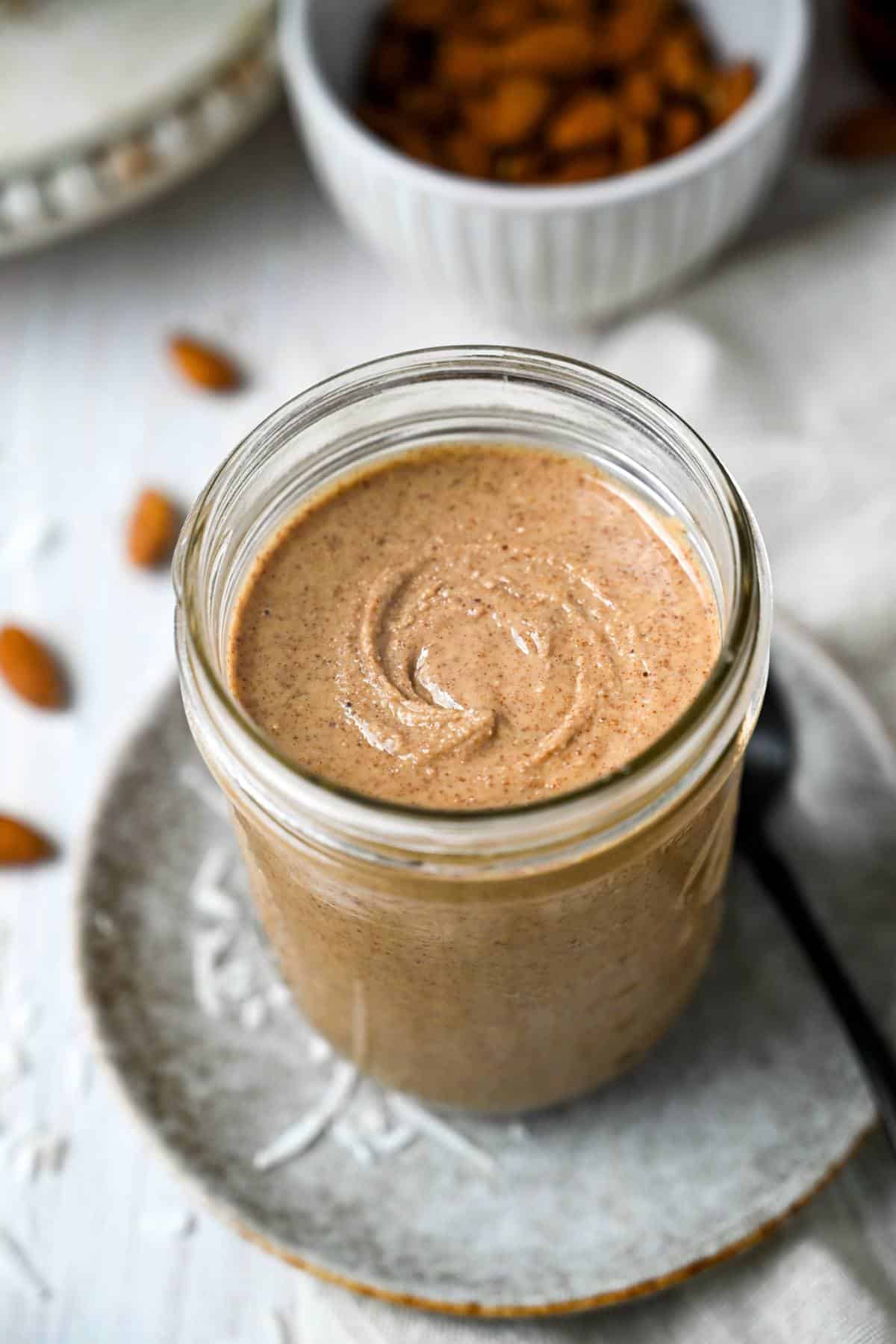
Looking for the best substitute for peanut butter? You’ve found it. This easy homemade almond butter recipe hits all the right notes—creamy, rich, and endlessly adaptable. Whether you’re baking, blending into smoothies, slathering on toast, or eating it by the spoonful (guilty), this nut butter does it all.
I honestly can’t believe it took me this long to make my own nut butter. Once you do it yourself, there’s no going back—not when you can control every ingredient that goes into the jar. No preservatives or additives here. Just toasted almonds, coconut flakes, maple syrup, a little coconut oil, and a pinch of salt!
The coconut flakes elevate classic almond butter to the next level, adding natural sweetness, a hint of tropical flavor, and contributing to a luscious, smooth texture. Whether you keep the coconut or try one of the fun flavors below, this is one of those recipes that’ll have you wondering why you ever bought the store-bought kind.
Why you’ll love it
- Wholesome. This almond coconut butter is made with just a handful of real food ingredients, naturally rich in healthy fats and protein.
- Customizable. Once you’ve got the basics down, the flavor possibilities are endless—try honey, maple, cinnamon, or even chocolate!
- Simple. It takes a little patience once you’ve added everything to the food processor, but the process is surprisingly hands-off. Just toast, blend, and enjoy!
Ingredients you’ll need
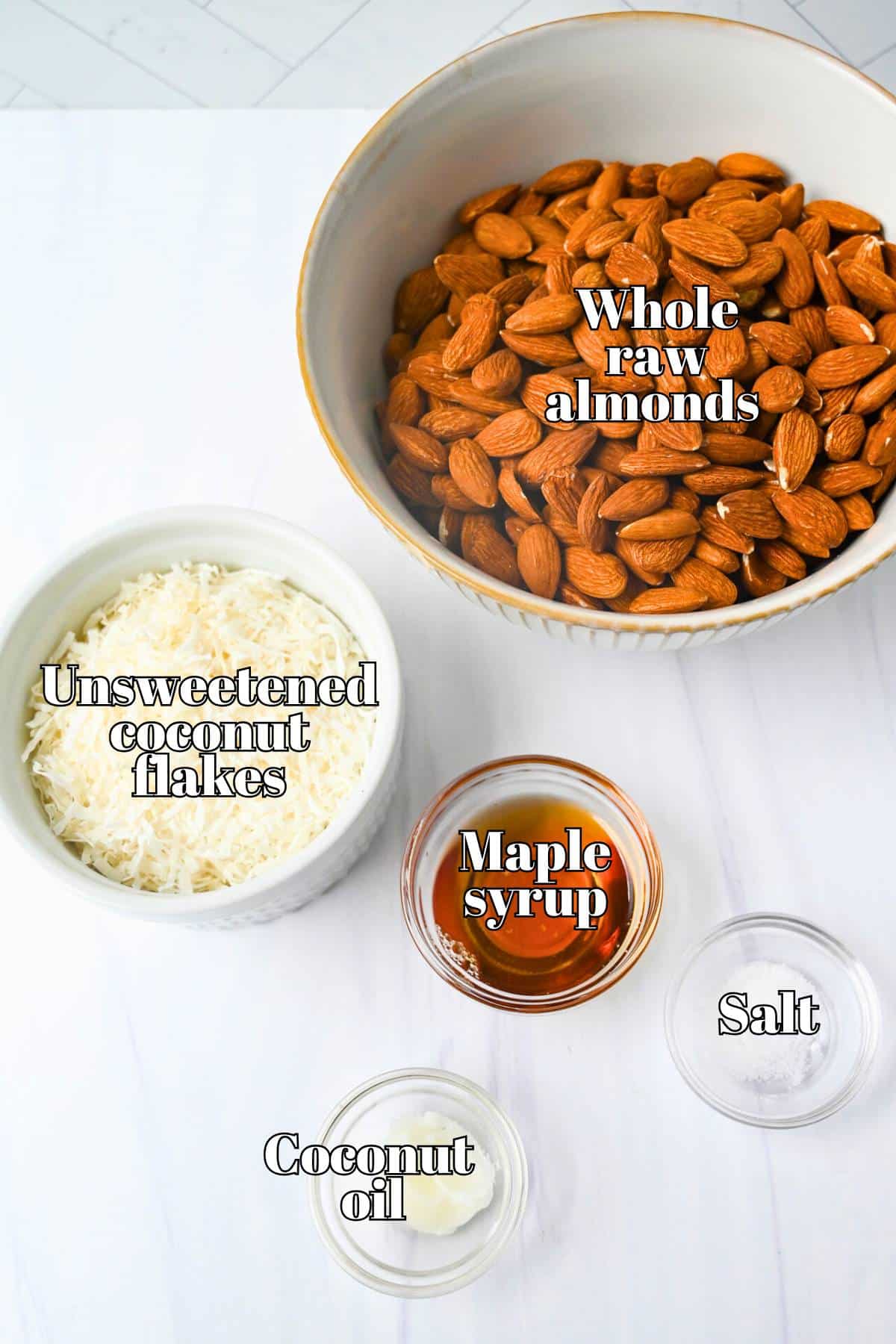
- Almonds. Whole raw almonds are the heart of this recipe. When roasted just right, their natural nuttiness deepens and they blend down into a luscious, creamy butter.
- Coconut flakes. Toasted right alongside the almonds, these add a beautiful toasty flavor, light sweetness, and help create a thick, cohesive consistency—just make sure you’re using unsweetened coconut flakes.
- Maple syrup. I add maple syrup to give the butter a subtle caramel-y finish. However, honey, date syrup, or agave nectar all work here.
- Salt. A pinch of salt makes the flavors pop. I usually use fine sea salt or pink Himalayan salt, but any kind will work.
- Coconut oil. High-quality coconut oil enhances the coconut flavor and makes the final texture more spreadable. I typically start with 1 teaspoon and add more if needed.
How to make almond coconut butter
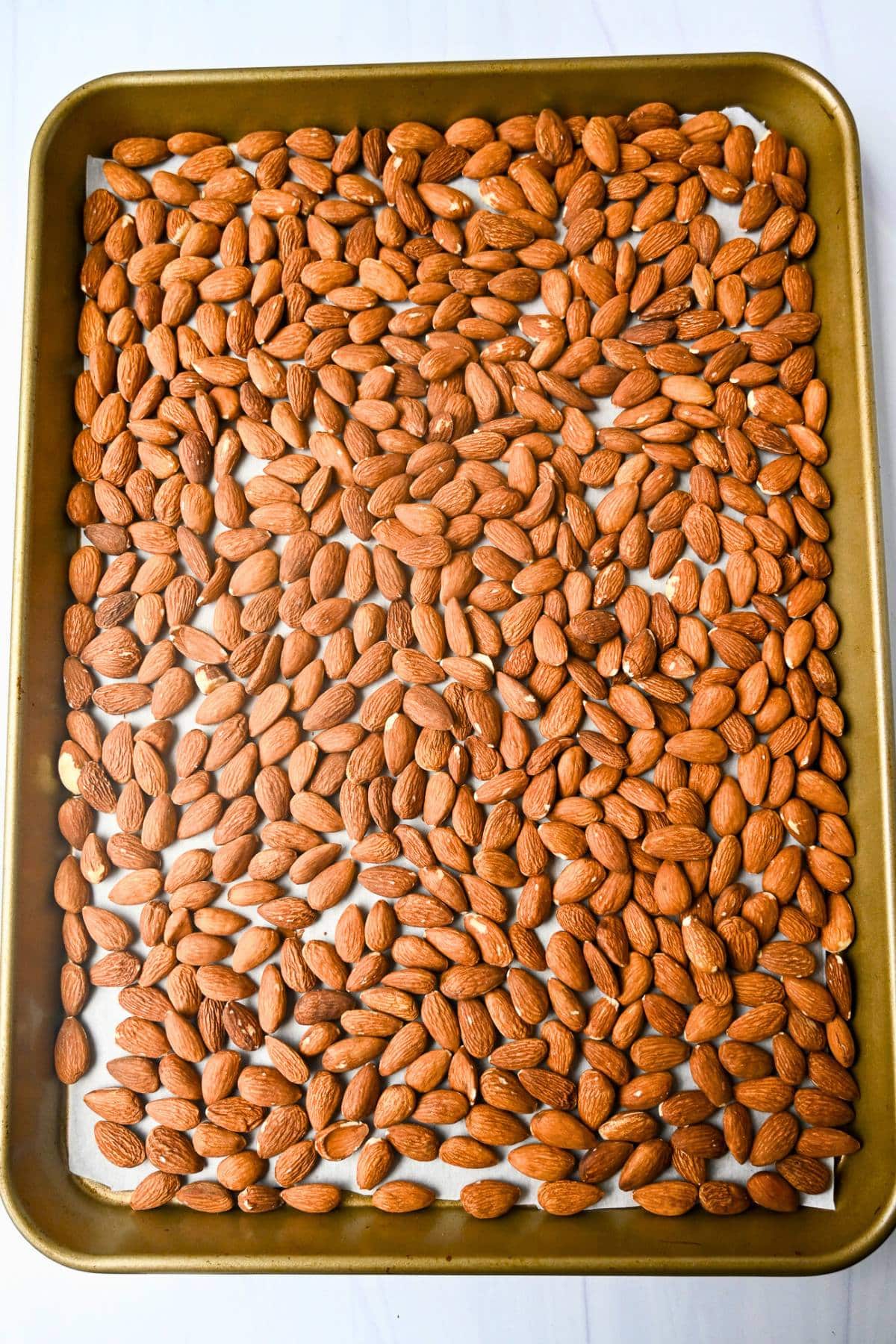
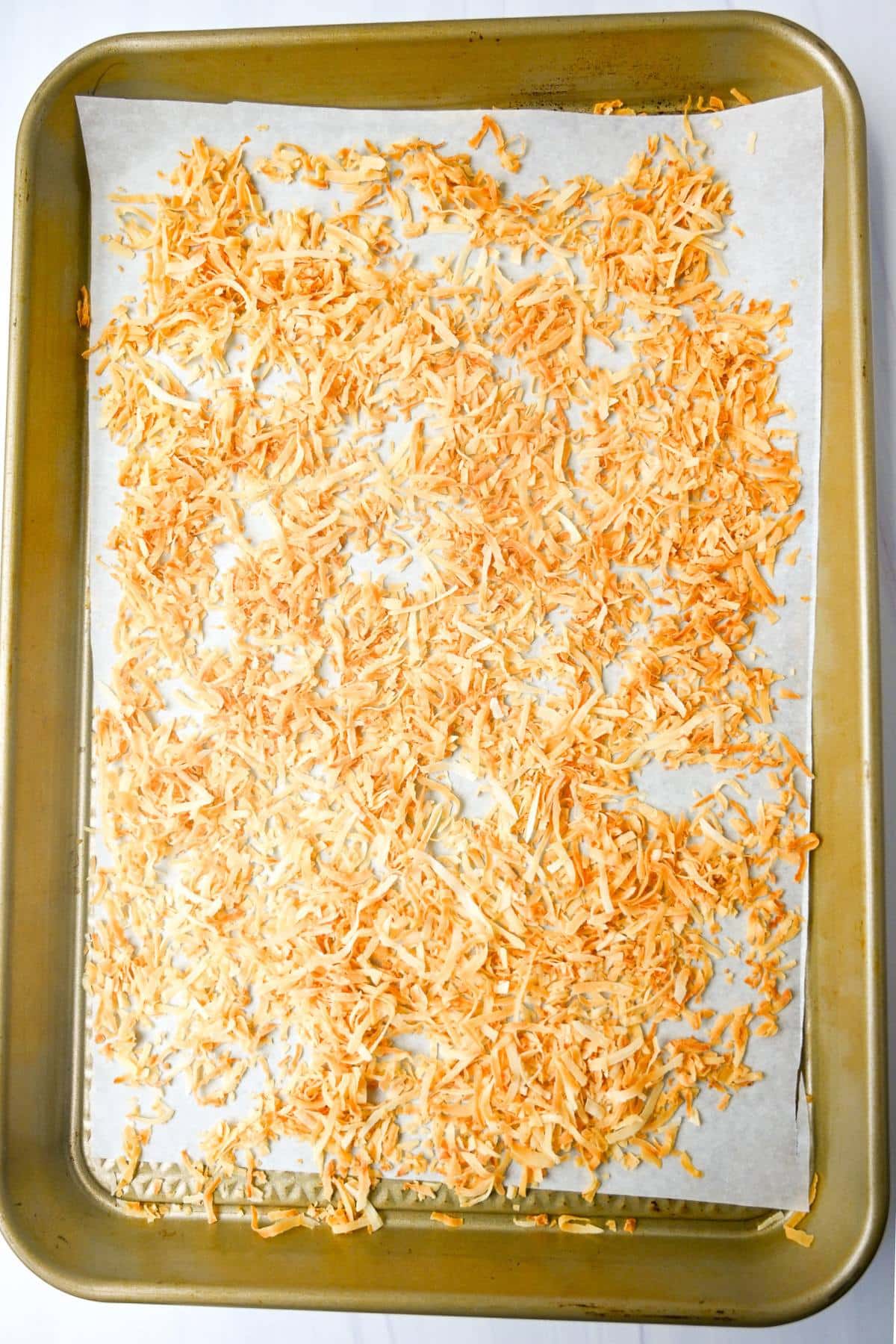
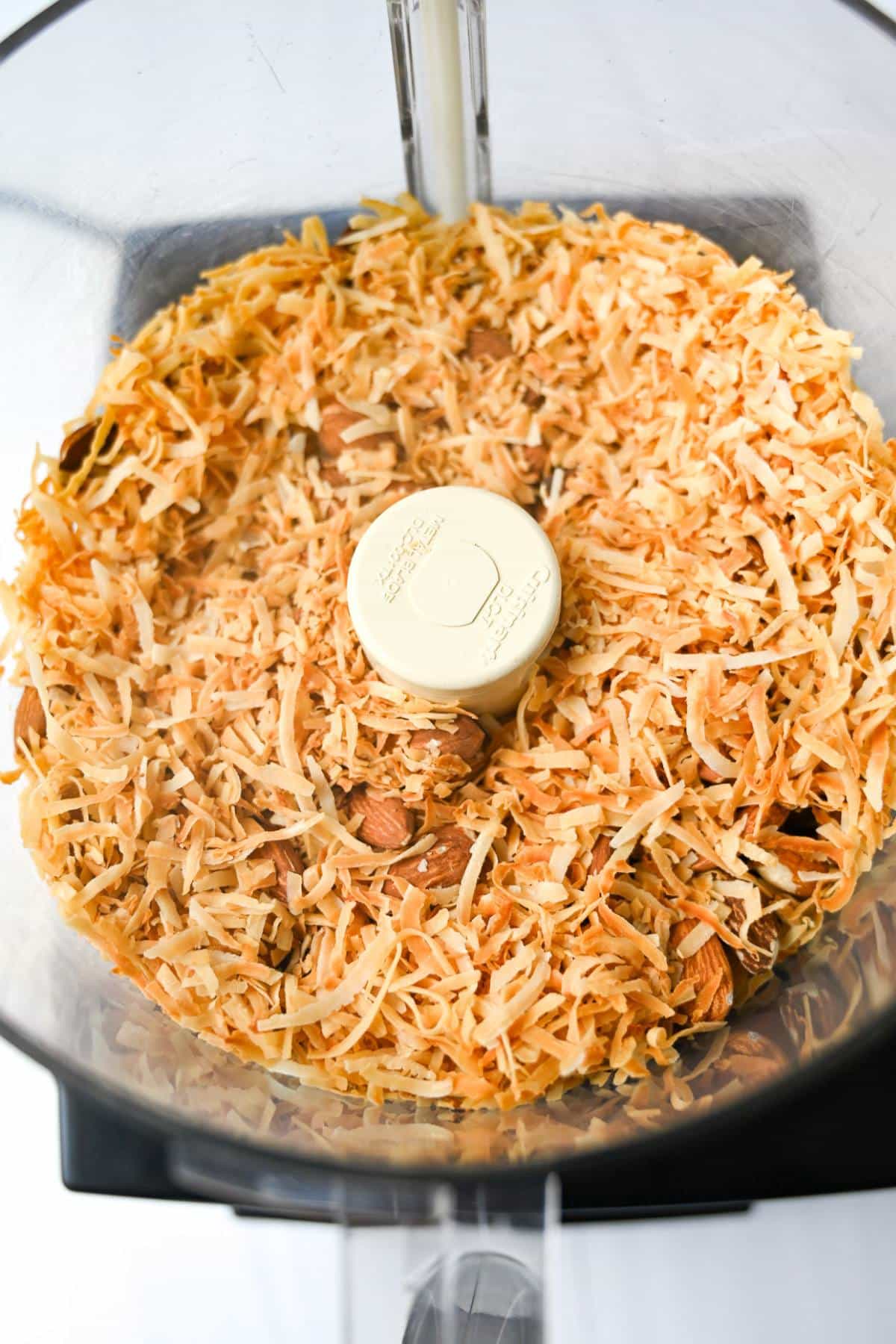
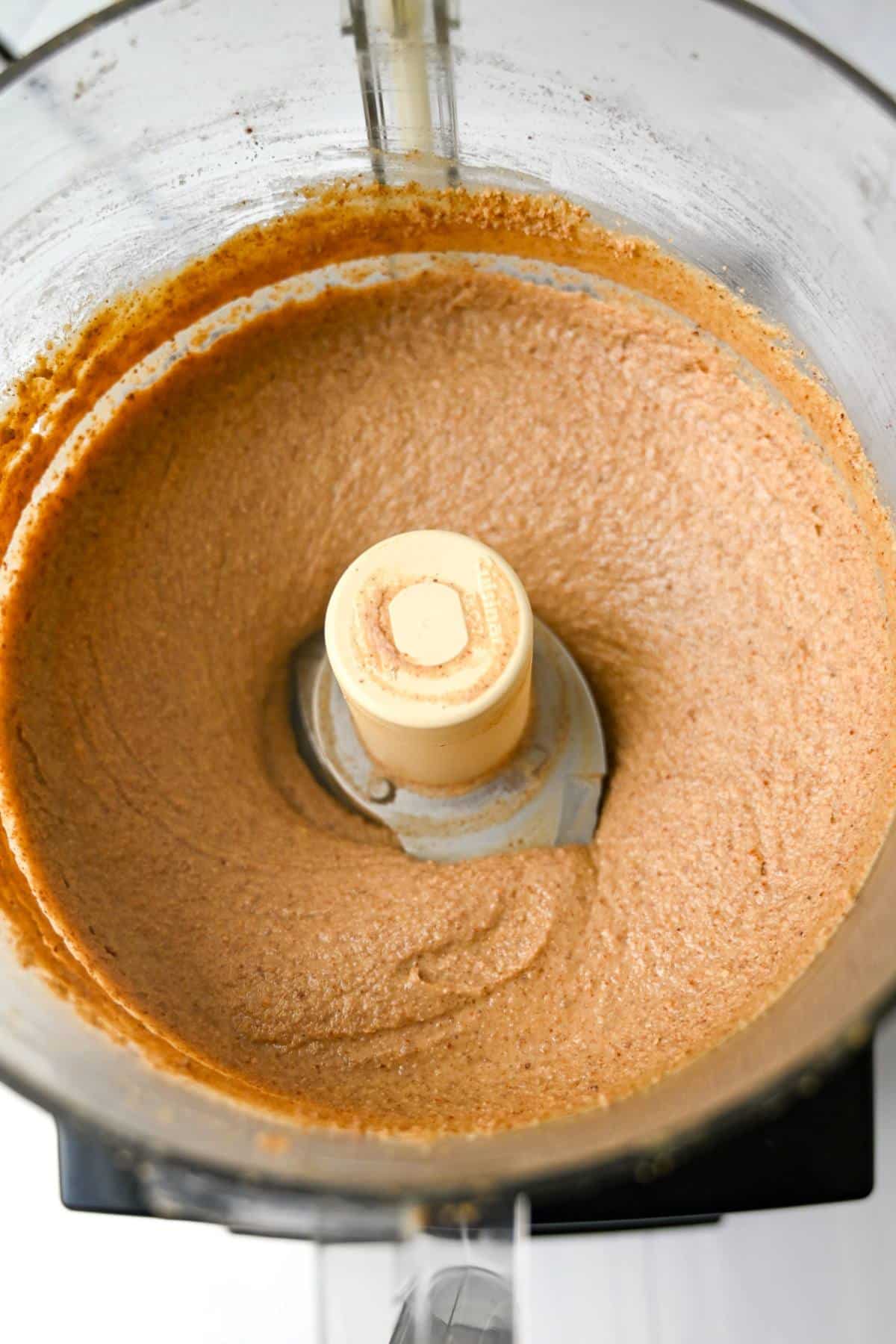
Step 1: Toast almonds. Spread the raw almonds out in a single layer on a baking sheet, then pop them in the 350°F preheated oven and roast for 10 minutes, stirring once halfway through.
Step 2: Add the coconut. During the last 3-4 minutes of toasting, spread the coconut flakes on the baking sheet alongside the almonds, or toast them separately on another tray for a little more control.
Step 3: Cool. After toasting, transfer the almonds and coconut to a bowl to cool.
Step 4: Start blending. Add the almonds to the bowl of a food processor fitted with the “S” blade, and begin processing, stopping every few minutes to scrape down the sides and break up the mound that forms.
Step 5: Add remaining ingredients. About halfway through, once the almonds start to resemble a thick paste, add your toasted coconut, maple syrup, salt, and coconut oil. Continue processing until it reaches your desired silky-smooth consistency.
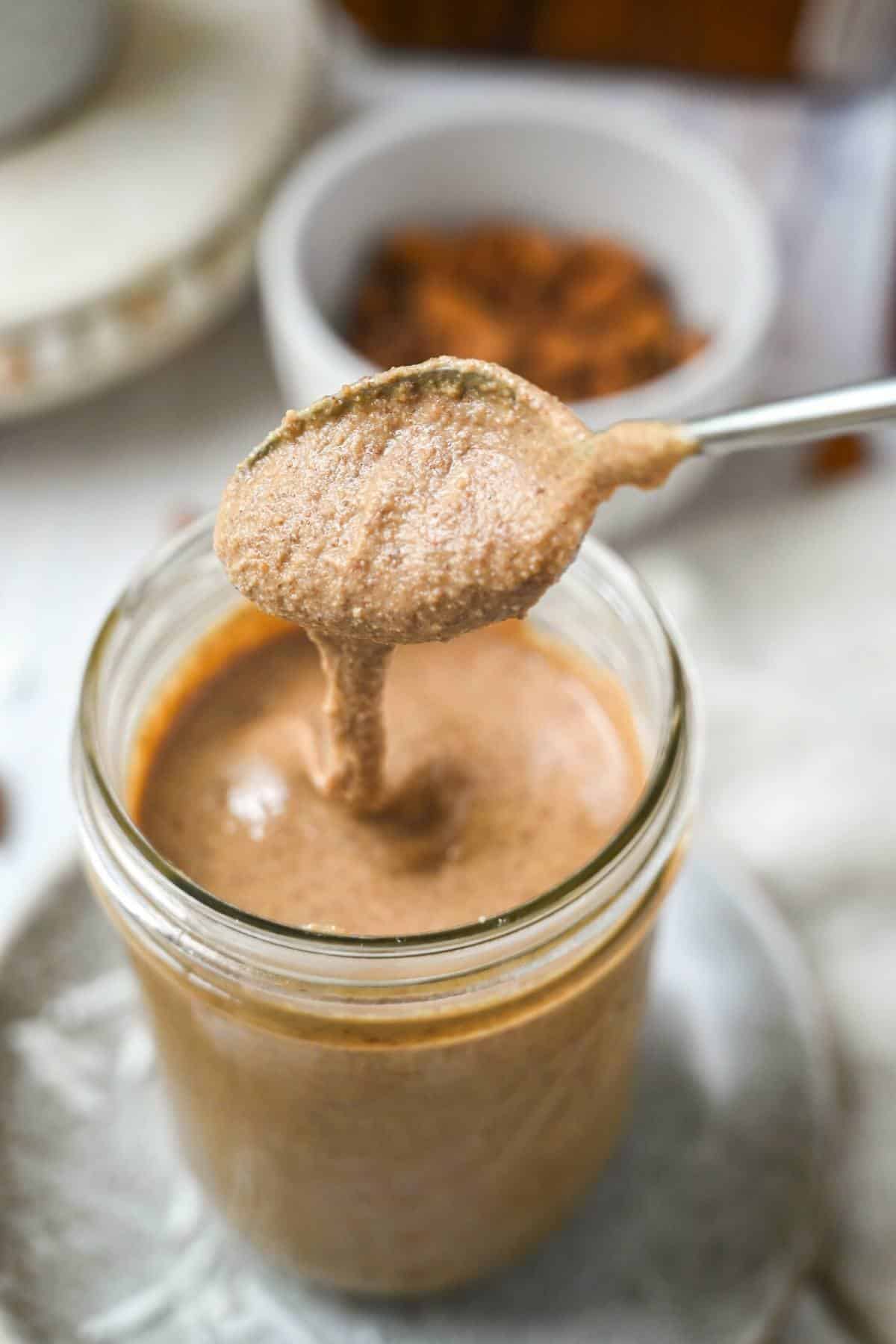
Recipe tips and FAQs
- To toast or not to toast? Toasting the almonds and coconut intensifies the flavor, which I love in this recipe. But if you prefer a milder, more delicate flavor, you can skip toasting the almonds. The coconut, however, should always be toasted, or it may stay too dry and fibrous to blend properly.
- Don’t burn your almonds—or your coconut! Burning either of these ingredients can cause bitterness. Your almonds should be light golden and fragrant when they come out of the oven, not dark brown. Coconut browns much faster than almonds, so add it during the last 3-4 minutes and keep a close eye on it.
- Cool before blending. Warm almonds and coconut blend better than cold, but blending while too hot can strain your machine. Let things cool down for 10-15 minutes to achieve the best texture and keep your equipment safe.
- Be patient—it will get creamy. The almond butter will go through phases: powdery→chunky→clumpy→ pasty→smooth. Just keep processing and scraping down the sides. It can take around 25 minutes, but once the oils release, the texture will suddenly transform into velvety goodness. Don’t give up!
Flavor variations
If you aren’t crazy for shredded coconut, you can easily omit it and introduce other fun flavors—just keep in mind that any add-ins should go in once the almonds have broken down into a thick paste to ensure the final texture stays smooth and creamy. Here are a few of my faves:
- Natural almond butter – This classic version is just the basics—almonds (roasting optional), sea salt, and coconut oil. Perfect as a starting point for your flavor experiments.
- Honey almond butter – Sweeten the butter with raw honey for a naturally sweet, slightly floral twist.
- Maple almond butter – Use dark amber maple syrup as your sweetener for an extra hint of warmth, coziness, and a touch of indulgence.
- Cinnamon almond butter – Add 1-2 teaspoons of ground cinnamon for a sweet and spiced version.
- Chocolate almond butter – Add 2-3 tablespoons of unsweetened cocoa powder and a dash of vanilla for a decadent, dessert-worthy spread.
Either works, but I recommend using unblanched almonds (with the skins on) for this recipe. They have a richer, toastier flavor and give the butter a slightly rustic texture and speckled appearance. Blanched almonds (skins removed) make a milder, smoother, and lighter-colored almond butter.
A high-powered food processor with a sturdy S-blade is key. I personally love my Cuisinart food processor—it delivers super creamy nut butter every time. High-speed blenders like a Vitamix can also work, but you’ll need to use the tamper and stop frequently to scrape down the sides. Smaller or less powerful machines may overheat or stall out before the nuts fully break down.
Storing and freezing
Storing: After blending, let your almond coconut butter cool completely before storing in a clean, airtight jar in the fridge for up to 2 weeks. It will firm up in the fridge, so just let it sit at room temperature briefly to bring it back to a spreadable consistency.
Freezing: This homemade nut butter also freezes beautifully. Simply spoon the mixture into a freezer-safe container, leaving a small amount of space at the top for expansion, and freeze for up to 3 months. Let it thaw at room temperature, then give it a good stir before using.
More homemade condiment recipes
If you love this creamy coconut and almond butter recipe, I would be so grateful if you could leave a 5-star 🌟 rating in the recipe card below. I love reading your comments and feedback!
Stay posted on my latest cooking adventures through social media @ Instagram, Pinterest, and Facebook. Also, don’t forget to tag me when you try one of my recipes!
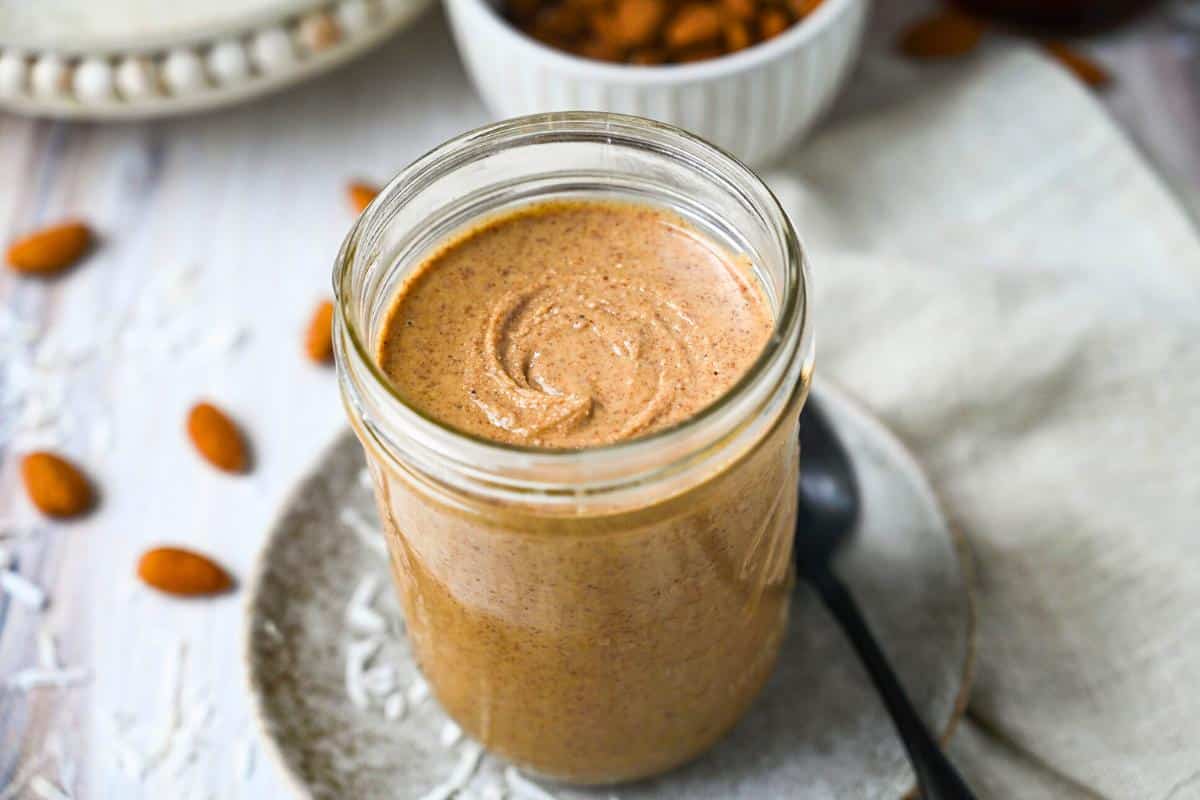
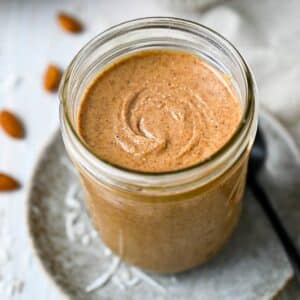
Toasted Coconut Almond Butter
Ingredients
- 4 cups whole raw almonds
- 1 cup unsweetened coconut flakes
- 2-3 tbsp good-quality maple syrup or honey, depending on your sweetness preference
- 1 tsp coconut oil
- 1/4 tsp sea salt
Instructions
- Preheat the oven to 350 degrees F. and line a baking sheet with parchment paper.
- Toast the almonds for 10 minutes, stirring halfway. They should be fragrant and lightly toasted. Add the shredded coconut for the last 3-4 minutes (or toast on a separate sheet), stirring a couple of times to avoid burning. Transfer the toasted almonds and coconut to a large bowl and set aside to cool.
- Using the “S” blade on a food processor, add your almonds to the bowl. Process nuts for about 25 minutes, stopping periodically to scrape down the bowl, breaking apart the mound when it starts forming into a ball.
- About halfway through, once the almonds start to resemble a thick paste, add your toasted coconut, maple syrup, salt, and coconut oil. You may feel like it’s never going to happen, then nuts finally break down and release their oils, creating creamy and delicious homemade almond butter! Be patient with this process. The almond butter will go through phases: powdery→chunky→clumpy→ pasty→smooth. Just keep processing and scraping down the sides. Once the oils release, the texture will suddenly transform into velvety goodness.
- Pour into jars and allow to cool completely before sealing and storing.
- Store in a covered container in the refrigerator for up to 2 weeks. *See tips for freezing instructions.
Notes
Nutrition
- Easy Eggnog Cupcakes with Spiced Rum Whipped Cream Frosting (Alcohol-Free Recipe) - December 15, 2025
- Southern Healthy Fried Chicken - November 10, 2025
- Ground Beef Breakfast Casserole - November 5, 2025

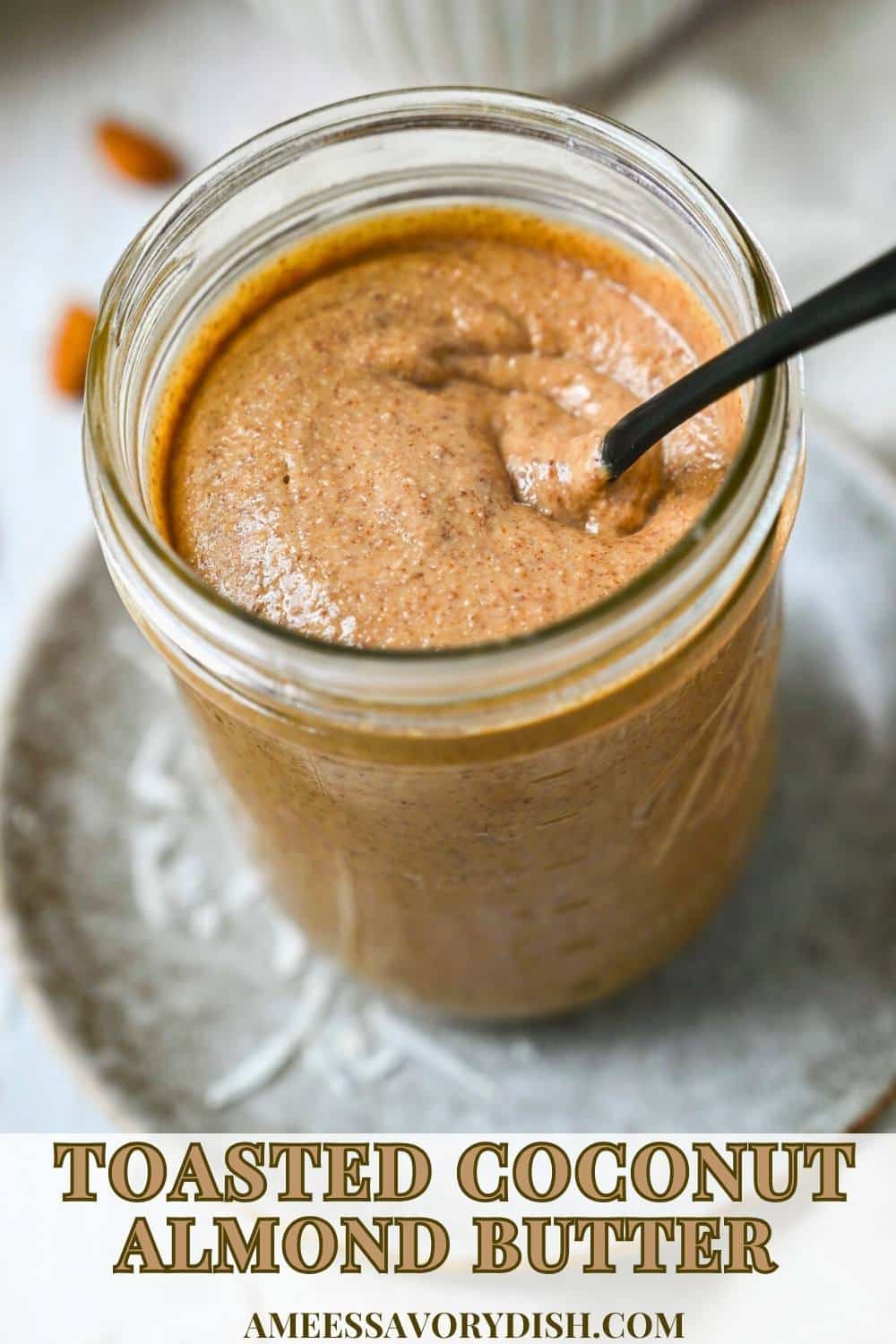
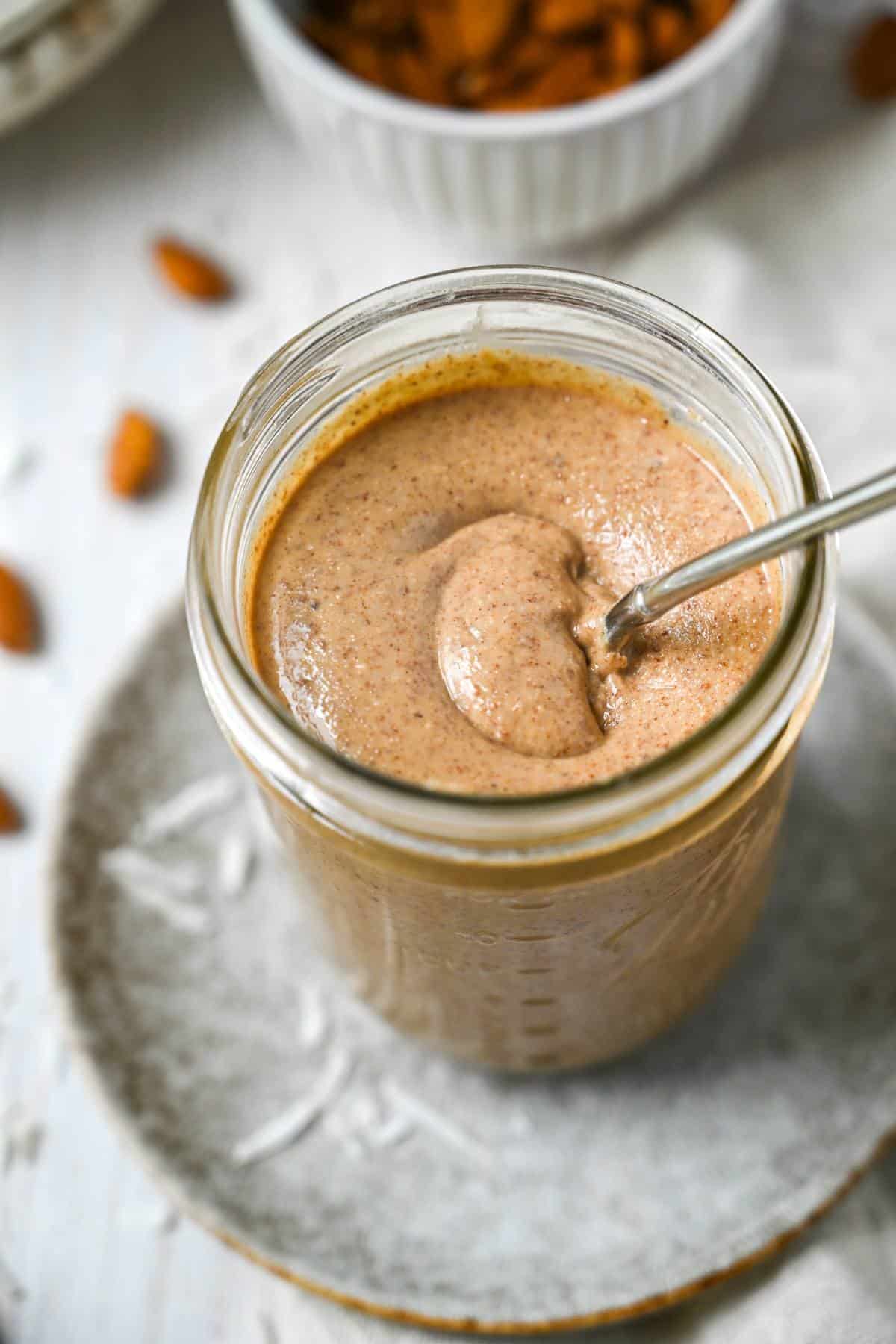
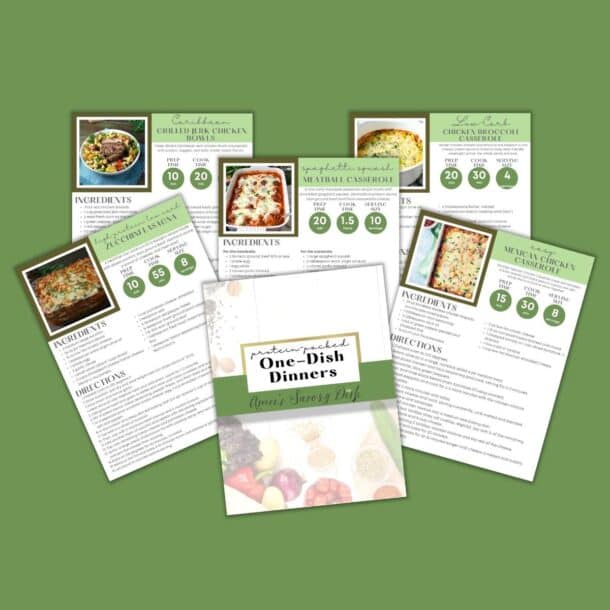
Thank you Marsha! xoxo~
This looks fantastic!! Thanks for sharing this amazing recipe.
Thank you ladies! You would use whole, raw almonds and toast them if you like the roasted flavor. I wouldn’t recommend using any that have been salted or cooked in oils.
Do they need to be raw almonds? Or can they be like what you would buy to eat from the grocery store?
Love this and all your options. Now that I have made cashew milk, I should really make my own nut butters!
Oh, I’ve never had maple almond butter. Can’t wait to try it!
Love this recipe